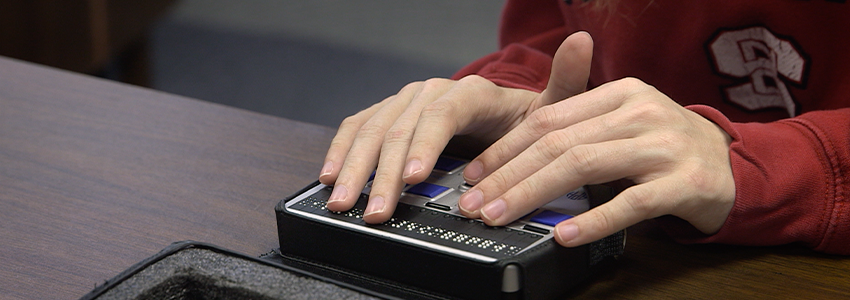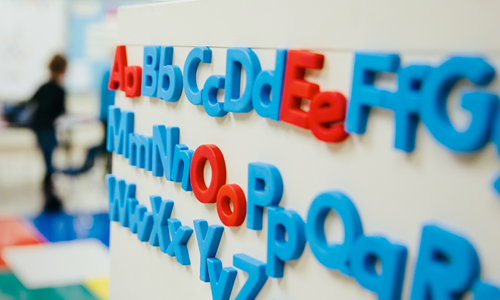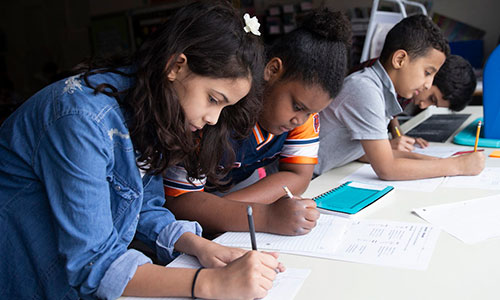
Every week, maybe even daily, my 14-year-old shows me changes in technology, such as the new cherry blossom grotto mod in Minecraft, new moves an NCP (non-player character, in case you’re wondering) can perform in his other games, or how he can add new sound effects to his stop-motion videos. He also shares how he uses AI to help him study for his science and math tests. That’s right. You read that correctly: “help him study,” not “help him cheat.”
Just like with many things in technology that get a bad rap, AI has certainly had its time being scrutinized. However, not all AI is bad. Like my son, the accessibility committee at NWEA is using AI for good with the support of Microsoft’s AI for Accessibility grant. The grant is funding our research into AI and how it can empower people with disabilities at home, in the community, and at school.
Exploring the potential for AI in education
At NWEA, we were lucky to be awarded a Microsoft grant and are using it to study how to improve access to mathematics materials for students with disabilities, specifically those who are blind or have low vision. My colleagues and I are focused on making complex middle school math materials more accessible for screen readers, refreshable braille displays, and voice activation.
COVID-19 school closures highlighted just how many barriers there are for students with disabilities attempting to access online math materials. While kids who are sighted had multiple way to access online materials during remote learning, students using assistive technology, such as refreshable braille and screen readers, had very limited options.
Research conducted by the US Department of Education found that 75% of visually impaired students are behind sighted peers in math by at least a full grade level. We want to ensure blind and low-vision students have equal opportunities to access math materials provided by their teachers.
Process-Driven Math as part of the solution
Process-Driven Math (PDM) has helped us use our grant funding to find viable solutions for using AI to improve access to online math materials for screen reader users.
PDM is a strategy that uses chunking to simplify complex mathematics. In “Process-Driven Math: An auditory method of mathematics instruction and assessment for students who are blind or have low vision,” professor Ann Gulley and her team explain that PDM was developed at Auburn University-Montgomery to support a student who is blind and unable to learn braille due to the lack of feeling in his fingers.
Gulley et al. explain that PDM is “a fully audio method of mathematics instruction and assessment.” PDM reduces the cognitive load students need to rely on to solve a math problem because it reads a math problem to a student one piece at a time, while also giving the student control over how quickly the information is read. In Gulley et al.’s words, PDM “delivers the overall landscape of the expression without overwhelming the student’s working memory.”
Our sample video on YouTube demonstrates how a screen reader might break down an equation for a student.
A summary of our research
In the first year of our research, we learned from existing studies that blindness or low vision does not affect a student’s ability to build strong math skills. It is lack of access to math materials that leads to this. The primary goal of our research, then, is to provide multiple means of output for math questions, that is, to make the questions easier for students to access using assistive devices such as a screen reader, refreshable braille, and voice-command chatbot.
In our work toward our goal, the first year of our study focused on understanding which MAP® Growth™ math questions posed barriers to students who use assistive technology. As we explain in our technical brief, we looked at data from nearly 30 million middle school students taking standard versions of MAP Growth and data from nearly 50,000 middle school students taking accessible versions. This helped us identify questions that succeed in measuring math achievement for students with visual impairments and questions that fall short. This, in turn, is helping us develop prototypes that rely on AI and PDM to improve the accessibility of all kinds of online math materials.
We are now in the second year of our work and have expanded our study to also explore the effective use of both UEB and Nemeth refreshable braille as well as voice command.
We are relying heavily on artificial intelligence to do this work by:
- Training GPT-4 to build algebraic expressions and equations that are accessible to screen readers and in line with PDM
- Training GPT-4 to build algebraic expressions and equations accessible for refreshable braille in both UEB and Nemeth
- Exploring the possibility of embedding an AI chatbot or virtual assistant into the math portion of MAP Growth to make it easier for students to access and respond to math questions using voice commands
In the disability community, there is a saying: “Nothing for us without us.” To truly use AI for good, we know we need to include the students we’re working to serve in our research. While some AI algorithms forget to take accessibility into account, our project does just the opposite. To ensure that whatever we create works well for all students, including those using assistive technology, we are user testing with middle and high schoolers who rely on using screen readers, refreshable braille, and magnification. So far, we have had more than 20 expressions and equations reviewed by students, and they have given us valuable feedback on our mistakes and what they think is accessible. Suggestions have ranged from “This is a really good one!” to “This is confusing. There are too many answer choices.”
It takes a village
To make lasting and positive changes in accessibility, we have worked with students and also other experts in the field. We have been in partnership with Geoff Freed, director of digital accessibility consulting at Perkins Access; Sarah McManus, digital learning director at Governor Morehead School, a school for the blind in North Carolina; Sonja Steinbach, a teacher for the visually impaired with Columbia Regional Inclusive Services in Oregon; and Neil Soiffer at Talking Cat Software, also in Oregon.
I look forward to sharing more on this work and our goals to make digital mathematics materials more accessible to all.







